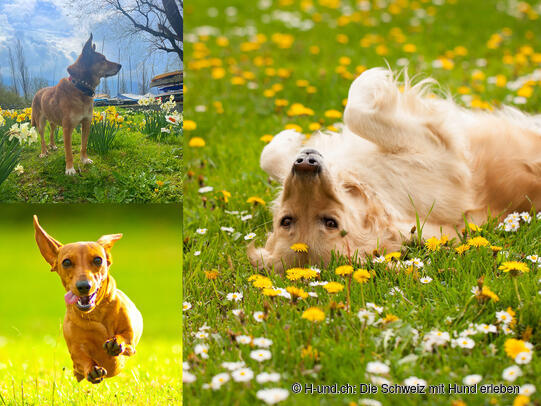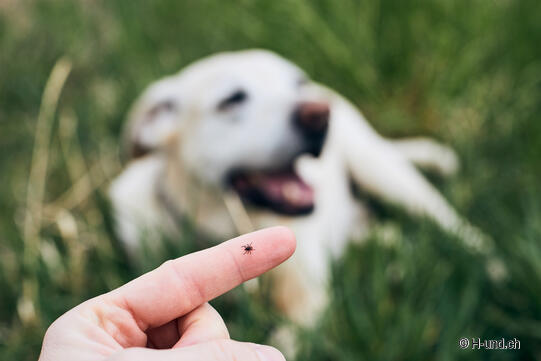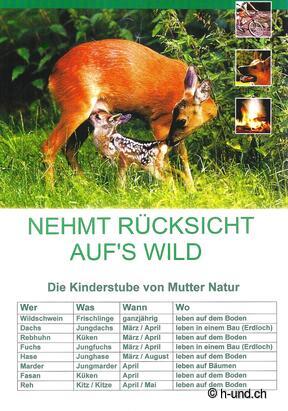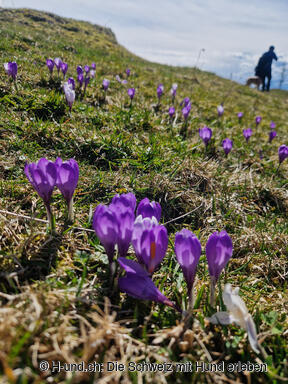Spring awakening
Nature awakens from hibernation
Even though there is still snow in many places and the ski season is underway, the harbingers of spring cannot be overlooked. Temperatures are rising, the first snowdrops are sprouting and the birds are chirping happily again. We are drawn outside. The cold and dark season is over.

A contribution by Anja Papenberg.
Spring not only awakens nature, but also our dogs' zest for life. The warmer season invites us to go for long walks with our four-legged friends to explore the diverse flora and enjoy the first rays of sunshine. Unfortunately, this time of year does not come without an annoying danger: ticks. The first reports of tick bites are already coming in. I myself collected one from my dog a few days ago. A tick bite, or rather the diseases that are transmitted by them, can be very dangerous for both humans and our dogs and can cause serious health problems. Effective tick prevention is therefore of crucial importance.
Why are ticks so dangerous?

Ticks are carriers of various diseases, including the dreaded Lyme disease and tick-borne encephalitis (TBE). Symptoms range from flu-like symptoms to severe neurological disorders. Pets are also at risk, whereby dogs in particular can be affected by so-called "babesiosis", a blood parasitosis transmitted by ticks.
Effective tick prophylaxis for humans:
- Suitable clothing: Wear light-colored, closed clothing to make it easier to spot ticks. Wear long pants and tuck them into your socks to prevent the little bloodsuckers from getting under your trousers.
- Insect repellent: Use an effective insect repellent on uncovered skin, preferably with the active ingredient DEET.
- Regular checks: After spending time outdoors, it is important to check your body thoroughly for ticks, especially in skin folds and hairlines.
Tick prophylaxis for pets:
- Tick repellents: there are various tick repellents for dogs and cats, from spot-on preparations to collars and medication. As with any product, there are various risks and side effects. You should therefore weigh up for yourself which risk you consider to be worse. The risk of a serious illness from a tick bite or the side effects of prophylactic medication.
- The herbal alternative: Of course, there are also plenty of herbal alternatives. It is not possible to say conclusively what helps best. Everyone has their own experiences and knows what works particularly well for their dog. In any case, prophylaxis should be used during the warm months, i.e. the tick season.
- Daily check: The most important thing is still to check your dog's coat thoroughly for ticks after every walk. Why not combine this with a relaxing massage or stroking session. A nice ritual after every walk.
- How to remove a tick: If a tick has already attached itself, remove it completely and as quickly as possible using suitable tools or tweezers. Unfortunately, there is only a vaccination against TBE. However, we refer you to the vets for this.
The risk of ticks is real, but with suitable precautions we can enjoy the warm spring days with our dogs without any worries. Prevention is good, but you shouldn't drive yourself crazy.
More spring dangers for our dogs
1. toxic baits and pesticides
It's not just us dog owners who are drawn outside by the milder temperatures. The gardening season is also slowly starting again - and fertilizers, pesticides or slug pellets are often used, which can be highly toxic to dogs. Pesticides are also often used in parks and fields. Therefore, dogs should not be left unsupervised to sniff around meadows or gardens or eat grass. Unfortunately, during the warmer months there are more and more reports of poisoned bait being laid out. Careful monitoring of the ground during walks and targeted anti-poison bait training can help to minimize the risk.
2. allergies and pollen
Did you know that not only us humans but also our dogs can suffer from allergies? Typical symptoms include itching, skin irritation, watery eyes and frequent sneezing. Dogs that spend a lot of time in high meadows or on flowering shrubs are particularly affected. If you suspect an allergy, contact your vet.
3. spring flowers - pretty, but poisonous!
Many early bloomers such as daffodils, tulips, crocuses and lilies of the valley are poisonous to dogs. Nibbling on these plants or ingesting bulbs and flowers can lead to digestive problems, vomiting or, in the worst case, serious poisoning. So when out walking and in your own garden, you should make sure that dogs do not nibble on or even eat unknown plants.
4. spring cleaning - avoid chemicals
Spring is also the time for thorough cleaning. However, many cleaning products contain ingredients that can be dangerous for dogs, especially if they lick freshly mopped floors or treated surfaces. If you want to be on the safe side, you can use natural alternatives such as vinegar or citric acid.
Breeding and setting season
Spring not only marks the beginning of the flowering season for nature, but also the breeding and mating season for many wild animals. For dog owners, this means being particularly attentive and considerate in order to protect the local wildlife and ensure harmonious coexistence. In many cantons, dogs must be kept on a lead from the beginning of April to the end of July.

Many wild animals such as deer, birds and hares give birth to their young during the breeding season. The young animals are particularly vulnerable in the first few weeks of their lives and can be endangered by external influences. Above all, by rummaging and poaching dogs. A danger that is real and, in the worst case, can cost the lives of the wild animals' offspring.
It would therefore be nice if all dog owners would adhere to the following rules:
1 Observe the leash requirement: Even if there is no official leash requirement in some places, it is desirable that dogs are kept on a leash in nature reserves, on forest edges and in the forest. Especially if I cannot guarantee a reliable recall for my dog. Romping alone or with dog buddies in high grass or bushes should also be avoided if possible, as wild animals often leave their offspring here. A dog does not have to run free to be happy and busy.
2. do not leave paths: Stay on designated paths to avoid disturbing nesting and breeding sites. Entering protected areas can be stressful for wild animals and reduce their chances of survival.
3. Consideration for wild animals: Make sure that your dog does not poach or chase wild animals. This can be dangerous not only for the animals, but also for your dog.
4.Obtain information: Find out about local rules and regulations regarding the breeding season in your area. This can vary from place to place. By obtaining information, conflicts can be avoided and we contribute to the protection of wild animals.
Spring is a beautiful time of year and we are all looking forward to getting out and about again. Nature delights us with its blossoming splendor. So let's be considerate and walk our dogs responsibly so that we don't disturb and protect the local wildlife. For a harmonious coexistence.
Your Anja & Sammy





